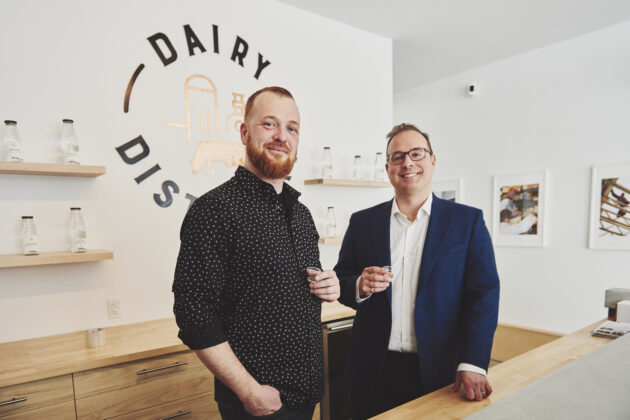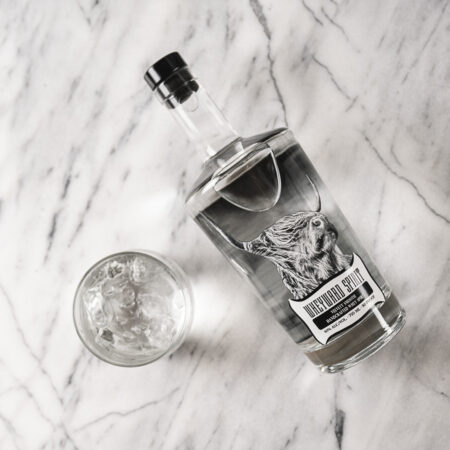
Unused dairy finds new uses in beverages
By Jane Dummer
Food Trends dairy food waste upcyclingThese companies create unique products with discarded whey and milk permeate
 Neal McCarten and Omid McDonald, founders of Dairy Distillery. Photo courtesy Dairy Distillery
Neal McCarten and Omid McDonald, founders of Dairy Distillery. Photo courtesy Dairy Distillery Upcycling is a new term for an old concept of using food processing by-products to generate new food ingredients. Years ago, we made sausages from meat scraps and jams from overripe fruit. Today, consumers want to reduce food waste. Upcycled ingredients offer food processors an innovative opportunity to create appealing, often nutritious ingredients and products for the market, while reducing food waste and supporting a circular economy.
Donna Berry, a Chicago-based dairy consultant agrees, “Upcycling is all about reducing food waste by taking overlooked ingredients and creating delicious new foods and beverages. That’s what the Spare Food Company is doing with its first creation of an effervescent drink called Spare Tonic.”
Spare Food Company
Spare Tonic is made using four ingredients: whey, fruit, spice, and a touch of honey. The latter acts as the fermentation catalyst.
“Spare Tonic naturally provides a good source of protein, is rich in electrolytes including calcium, magnesium, and potassium, and is an excellent source of vitamins B6 and B12. It has a natural 3:1 carbohydrate to protein ratio, which makes it ideal as a post-workout recovery beverage. It consists of about 85 to 95 per cent whey that would have otherwise been discarded from the production of strained yogurt. For every one cup of strained yogurt produced, two cups of whey are created,” says Berry.
Whey is naturally acidic, so it must be neutralized before going into the waste stream or it could wreak havoc on the ecosystem.
“Spare Tonic captures what would have been the lost value of this whey (nutritionally, economically, and environmentally) and crafts it into the beverage,” adds Berry.
Spare Food sources whey from the White Moustache in Brooklyn, which uses milk from Hudson Valley, New York-based dairy farms. According to Berry, ever since Spare Food started purchasing the excess whey to make Spare Tonic, the White Moustache has been able to expand its yogurt production, which, in turn, means they have been able to hire more people and buy more milk.
Spare Tonic is available in four flavours and comes in 12-ounce cans, with one can containing 100 to 120 calories.

Wheyward Spirit uses whey and proprietary fermentation and distillation techniques to create its award-winning spirits. Photo courtesy Wheyward Spirit
Wheyward Spirit
Upcycling dairy ingredients to the spirits industry sounds like an odd transition at first. Underutilized by-products of whey and milk permeate are used to create unique, fresh spirits in the United States and Canada.
Emily Darchuk, founder and CEO, Wheyward Spirit, explains, “Wheyward Spirit is a mission-driven company with the aim to transform the spirit and dairy industries for the better by making a sippable, sustainable spirit through repurposing the whey that typically goes to waste. We are female-owned, operated, and distilled, which is rare in spirits. It gives a fresh voice and thoughtful approach to not only what we make, but [also] how we make it. Wheyward Spirit’s versatile signature flavour profile has been described as ‘vodka and sake had a baby.’ This comes from our whey base and proprietary approach to fermentation and distillation. As a result, our lovely, unique flavour profile has won gold and double gold at San Francisco World Spirits Competition and New York World Spirits Competition, respectively.”
Wheyward Spirit works with California dairies to recapture their whey. “The hardest part is setting up the initial load since all the specifications, quality metrics and certifications must be met for our loads. It often creates an entirely new production stream since the dairies are accustomed to unloading their whey into outlets like animal feed. We work closely with our sourcing partners to make the transition easy, since their core focus is cheese production, and our goal is to upcycle the whey into our award-winning spirit,” explains Darchuk.
Wheyward Spirit can be purchased online and is shipped across the United States. It is also sold in select stores in Oregon and California.
Dairy Distillery
In addition to whey, milk permeate is being upcycled to create spirits. Milk permeate is produced during the filtration process to make skim milk. A lactose-rich by-product, milk permeate contains almost no proteins or fats, which makes it ideal for alcohol production.
Omid McDonald, founder, Dairy Distillery based in Almonte, Ont., explains, “When we first released our Vodkow vodka, we were worried about how people would react to the waste reuse. So, we used the term ‘unused milk sugar.’ We were pleasantly surprised to find consumers liked our upcycling of a waste stream. With the increasing focus on food security and carbon footprint reduction, we feel our products are well positioned. We work with Lactalis dairy processing plant in Winchester, Ont., and take in 18,000 L of milk permeate every week or almost 1 million L a year, which would otherwise go unused. We’ve found processors are supportive of our efforts since they are eager to find new uses for their by-products.”
Fermenting lactose is technically difficult. In the beginning, Dairy Distillery didn’t have access to the required yeast. Therefore, they worked with Professor Poulain and his research student Jessica Gaudet at the University of Ottawa to find a yeast that consumed lactose. After 18 months, Gaudet found a yeast that fermented milk permeate.
“With success in the lab, we moved to build our distillery. Once we add this special yeast into our fermenters, it takes two days to convert all the lactose into alcohol. We then use standard distillation to concentrate the alcohol, which is used to make our vodka and cream liqueurs (and hand sanitizer),” explains McDonald.
Vodkow vodka and cream liqueurs are available at the distillery, online, and at retailers like LCBO, SAQ, BC Liquor Stores and Wine and Beyond in Alberta.
This article was originally published in the August/September 2022 issue of Food in Canada.
Print this page